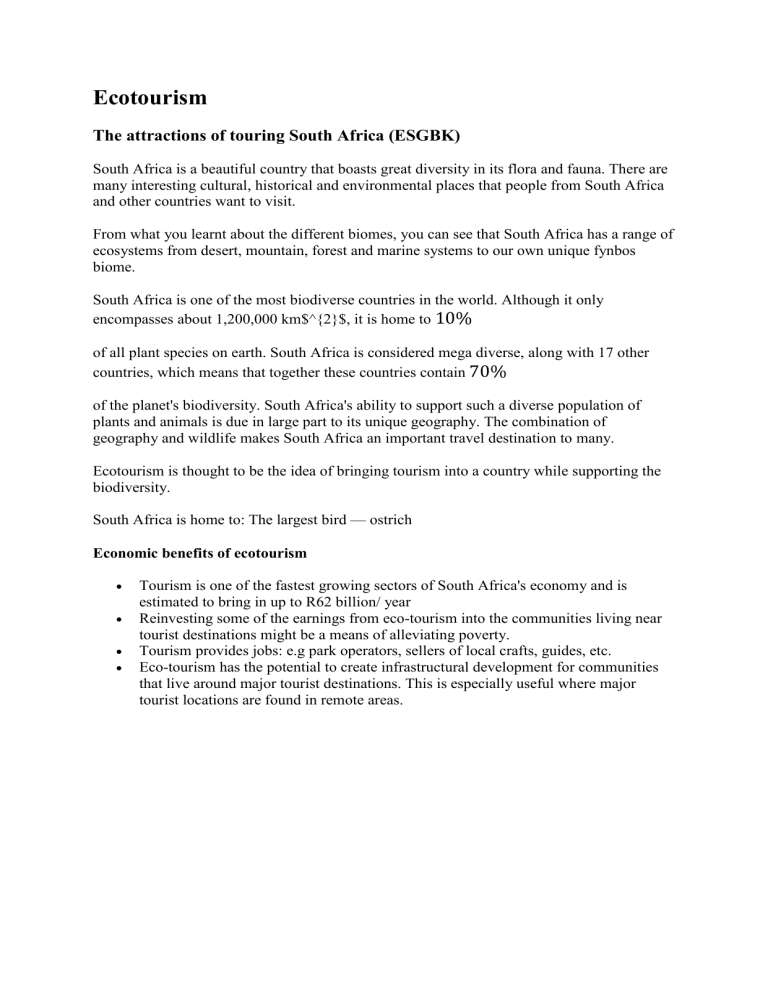
Ecotourism
The attractions of touring South Africa (ESGBK)
South Africa is a beautiful country that boasts great diversity in its flora and fauna. There are
many interesting cultural, historical and environmental places that people from South Africa
and other countries want to visit.
From what you learnt about the different biomes, you can see that South Africa has a range of
ecosystems from desert, mountain, forest and marine systems to our own unique fynbos
biome.
South Africa is one of the most biodiverse countries in the world. Although it only
encompasses about 1,200,000 km$^{2}$, it is home to 10%
of all plant species on earth. South Africa is considered mega diverse, along with 17 other
countries, which means that together these countries contain 70%
of the planet's biodiversity. South Africa's ability to support such a diverse population of
plants and animals is due in large part to its unique geography. The combination of
geography and wildlife makes South Africa an important travel destination to many.
Ecotourism is thought to be the idea of bringing tourism into a country while supporting the
biodiversity.
South Africa is home to: The largest bird — ostrich
Economic benefits of ecotourism
Tourism is one of the fastest growing sectors of South Africa's economy and is
estimated to bring in up to R62 billion/ year
Reinvesting some of the earnings from eco-tourism into the communities living near
tourist destinations might be a means of alleviating poverty.
Tourism provides jobs: e.g park operators, sellers of local crafts, guides, etc.
Eco-tourism has the potential to create infrastructural development for communities
that live around major tourist destinations. This is especially useful where major
tourist locations are found in remote areas.
Figure 8.25: Cape Town, South
Africa is a world-renowned tourist destination.
8.26: A baby impala in the Kruger National Park.
Figure
Ethical issues
While tourism has great economic potential and gives people access to unique places and
cultures, it can have a negative impact. Sensitive ecosystems, such as wetlands and coasts,
need to be protected so that the balance of organisms can be maintained. Too many visitors,
and visitors who are not informed about their impact on the environment, can have a harmful
effect. In the same way tourists need to be sensitive to the cultures and people that they visit.
To protect the plants and animals in the unique ecosystems of South Africa, many areas have
been declared National Parks and have strict rules about how to behave.
In the same way, places that are historically or culturally important have been declared
national heritage sites that are protected and maintained. South Africa is also proud to have
eight UNESCO (The United Nations Educational, Scientific and Cultural Organisation) sites:
Cultural
o Fossil Hominid Sites of Sterkfontein, Swartkrans, Kromdraai, and Environs
(1999)
o Mapungubwe Cultural Landscape (2003)
o Robben Island (1999)
o Richtersveld Cultural and Botanical Landscape (2007)
Mixed
o UKhahlamba / Drakensberg Park (2000)
Natural
o Cape Floral Region Protected Areas (2004)
o Greater St. Lucia Wetland Park (1999)
o Vredefort Dome (2005)
How to be a responsible ecotourist (ESGBM)
Many areas of South Africa are protected. When travelling to these areas, you need to respect
the area and the people that you are visiting. These are a few tips:
Learn a little about the place you are visiting before you go in order to be aware of the
do's and don'ts. For example, littering is not allowed in any National Park in South
Africa.
South Africa is rich in cultural diversity, which means that people from different areas
have different ways of doing things. Learn about the culture of local people so that
you can make sure not to offend anyone by your behaviour.
When you are in a protected area, do not damage plants or animals or buildings. For
example, writing graffiti on historical buildings or sites. Remember the saying: take
only pictures, leave only footprints.
